Citizens of Color, 1863-1890:
The "Talented Tenth"
|
|---|
Charles Ethan Porter
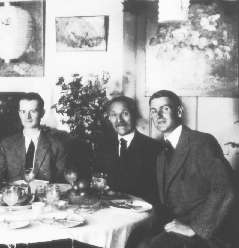 Mounting racism certainly was a barrier that
narrowed the range of employment and limited the satisfaction that would result from work, but it was
somewhat more permeable for Blacks with unique talents or abilities. Such a person was Charles Porter,
who has recently been rediscovered as a major 19th painter. He is shown here in about 1911 with a couple
of his students at a dinner party. Only a small portion of his works are known today, and what we do have
tends to be work done in old age after the height of his creative vigor had already passed.
Mounting racism certainly was a barrier that
narrowed the range of employment and limited the satisfaction that would result from work, but it was
somewhat more permeable for Blacks with unique talents or abilities. Such a person was Charles Porter,
who has recently been rediscovered as a major 19th painter. He is shown here in about 1911 with a couple
of his students at a dinner party. Only a small portion of his works are known today, and what we do have
tends to be work done in old age after the height of his creative vigor had already passed.
|

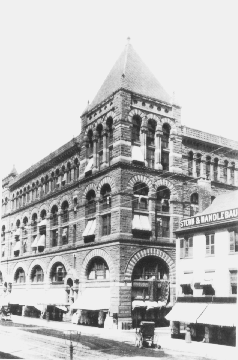 Porter's family had lived in Hartford since the 18th century, but his father moved to a house
in Rockville while Charles was a young boy (we are not sure of his birthdate, which was
approximately 1847-50). It appears that, although Porter kept a studio in a tower on a Rockville
hilltop not far from his family's home (where this landscape painted in about 1880, during his
experimentation years), by 1877 he had also established a studio in downtown Hartford and by
then he had also exhibited. Shown here is his Hartford studio in the tower of the Cheney Block on Main
Street. We name the building today after Richardson, who designed it.
Porter's family had lived in Hartford since the 18th century, but his father moved to a house
in Rockville while Charles was a young boy (we are not sure of his birthdate, which was
approximately 1847-50). It appears that, although Porter kept a studio in a tower on a Rockville
hilltop not far from his family's home (where this landscape painted in about 1880, during his
experimentation years), by 1877 he had also established a studio in downtown Hartford and by
then he had also exhibited. Shown here is his Hartford studio in the tower of the Cheney Block on Main
Street. We name the building today after Richardson, who designed it.
|
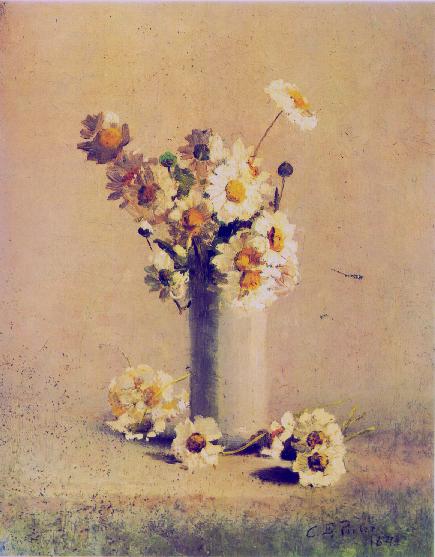 Thanks to the sponsorship of Mark Twain, Porter was able to go to
Paris in 1981-84, where he came under a variety of influences and was able to reach the heights
of his ability. This still life vase of daisies is a work done in his Hartford studio in 1884 shortly
after his return.
Thanks to the sponsorship of Mark Twain, Porter was able to go to
Paris in 1981-84, where he came under a variety of influences and was able to reach the heights
of his ability. This still life vase of daisies is a work done in his Hartford studio in 1884 shortly
after his return.
Although Porter's personal life is a bit obscure, it is evident that he encountered a city
in which racism was increasing in intensity. Porter was acclaimed by the press and was awarded
important prizes, but after settling in Hartford (he actually spent time travelling and also working in
his New York and Rockville studios - until the latter was hit by lightening), his race began to result
in social isolation. A Bavarian artist who shared his studio, Gustave Hoffman, had to sell Porters
paintings door to door because no one would buy the work of a Black man. It is said that a significant
part of his output in these years still hang unrecognized on the walls of Hartford homes. By the time
of his death in 1923, racism had cast him into complete obscurity, and it was only very recently
that he is once again recognized as one of the country's outstanding late nineteenth-century artists.
For an assessment of Porter's experience in Hartford's Black community, there is a useful study by
Professor James Miller, "Charles Ethan Porter and the Hartford Black Community," in Charles
Ethan Porter (1847?-1923) (Marlborough: The Connecticut Gallery, Inc., 1987).
Holdridge Primus
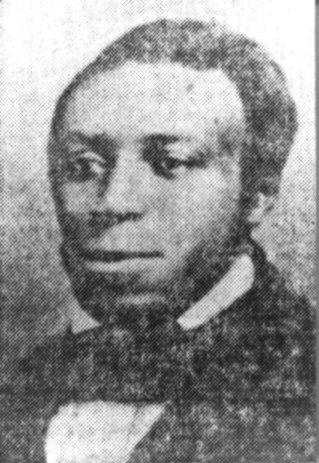 The Primus family can be traced back to a Black freeman, simply named Primus, who was servant and
apprentice of a Dr. Wolcott in the mid-18th century East Windsor area. He went on to become a doctor
himself. One of his immediate descendents was the sailor, Ham Primus, whose service was so outstanding
he gained a status rare for Blacks: American citizenship. He married Temperance Asher, and their children
were an important part of Hartford's early Black community. Holdridge Primus was one of their children.
This is a photo of him from the article, "The Colored People Who Live in Hartford," in the Hartford
Courant of 24 October 1915.
The Primus family can be traced back to a Black freeman, simply named Primus, who was servant and
apprentice of a Dr. Wolcott in the mid-18th century East Windsor area. He went on to become a doctor
himself. One of his immediate descendents was the sailor, Ham Primus, whose service was so outstanding
he gained a status rare for Blacks: American citizenship. He married Temperance Asher, and their children
were an important part of Hartford's early Black community. Holdridge Primus was one of their children.
This is a photo of him from the article, "The Colored People Who Live in Hartford," in the Hartford
Courant of 24 October 1915.
|
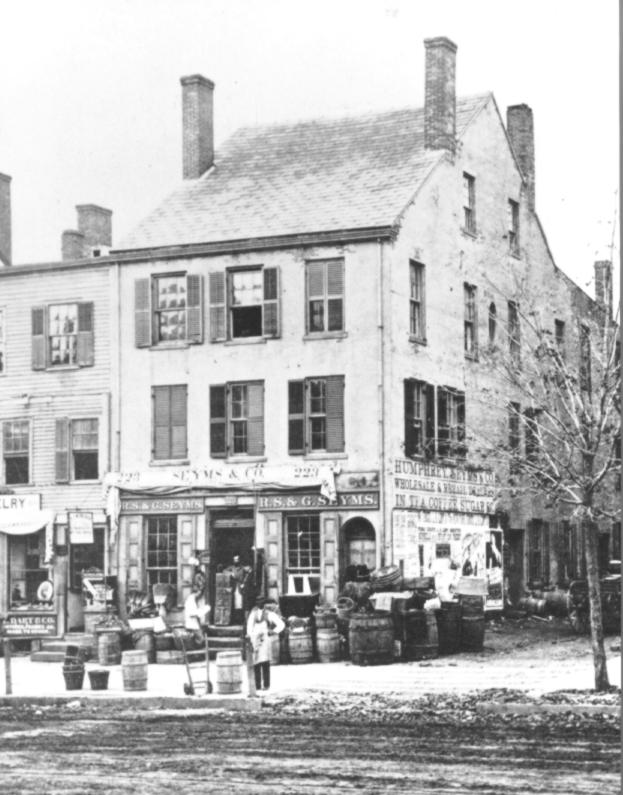 Holdridge was employed as a clerk at Humphrey and Syms, which sold sugar, coffee and tea, during
much of his life and eventually became a silent partner. Here he can be seen standing in the light snow
in about 1860 in front of the store (Connecticut Historican Society Museum). He married Mehitable Jacobs,
a dressmaker and a founder of the Talcott Street Congregational Church. By 1850 the couple had acquired
a home at 20 Wadsworth Street, and were considered wealthy for a Black family.
Holdridge was employed as a clerk at Humphrey and Syms, which sold sugar, coffee and tea, during
much of his life and eventually became a silent partner. Here he can be seen standing in the light snow
in about 1860 in front of the store (Connecticut Historican Society Museum). He married Mehitable Jacobs,
a dressmaker and a founder of the Talcott Street Congregational Church. By 1850 the couple had acquired
a home at 20 Wadsworth Street, and were considered wealthy for a Black family.
Among their four children
was Rebecca, who was a Maryland schoolteacher with the Freedman's Bureau, where she sought to
advance the condition of Black people. When she returned to Hartford she married a Charles Thomas
and fell into obscurity, but continued to teach at the Talcott Street Church school.
Another child was Nelson Primus, who apprenticed as a carriage maker and painter. In 1864 he
moved to Boston to begin a career at a portrait painter. His work was exhibited in Hartford and Boston, for
at the time downtown Hartford had a lively art colony (that included Charles Porter), and these artists used
their studies to exhibit their own art and that of others. To see illustrations of his portraits, read the book,
Art and Artists in Connecticut.
|